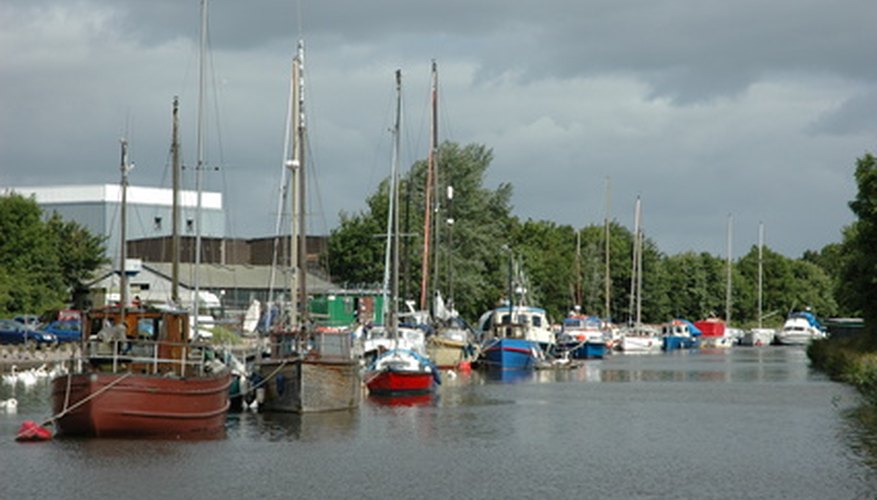Accountants must depreciate all assets. An asset is anything that will provide future value to the company.
If a company owns boats, then they must depreciate the boats in order to comply with the generally accepted accounting principals (GAAP). The accountant can use three different depreciation methods. These methods include straight line depreciation, double declining depreciation and sum of years' digits depreciation. The type of method to use depends on the accountant's preference and the company's past history of depreciating assets.
- Accountants must depreciate all assets.
- If a company owns boats, then they must depreciate the boats in order to comply with the generally accepted accounting principals (GAAP).
- Accountants must depreciate all assets.
- If a company owns boats, then they must depreciate the boats in order to comply with the generally accepted accounting principals (GAAP).
Find the cost of the boat, estimate the useful life of the boat and estimate how much the boat is worth at the end of the useful life. For example, a boat costs £32,500. The company estimates they will use the boat for 20 years and sell the boat for £6,500 at the end of the 20 years.
Add 1 to the useful life, then multiply the result by 1. Then divide the number by 2. In the example, 20 plus 1 equals 21. Then 21 times 20 equals 420. Finally, 420 divided by 2 equals 210. This is the denominator for the depreciation rate.
Divide the remaining useful life of the asset at the beginning of the year by the denominator of the depreciation rate to calculate the depreciation rate. In the example, for year 1, 20 divided by 210 equals a depreciation rate of 0.095238095 for the first year. For year 2, 19 divided by 210 equals 0.09047619 for the second year. Repeat this calculation for each year.
- Add 1 to the useful life, then multiply the result by 1.
- In the example, for year 1, 20 divided by 210 equals a depreciation rate of 0.095238095 for the first year.
Subtract the boat's worth at the end of the useful life from the cost of the boat. This is the depreciable base. In the example, £32,500 minus £6,500 equals £26,000.
- Find the cost of the boat, estimate the useful life of the boat and estimate how much the boat is worth at the end of the useful life.
- Subtract the boat's worth at the end of the useful life from the cost of the boat.
Multiply the depreciable base from Step 4 by the depreciation rate from Step 3. In the example, for year 1, the depreciation is £26,000 times 0.095238095, which equals £2,476.1 of depreciation. For year 2, the depreciation is £26,000 times 0.09047619, which equals £2,352.3 of depreciation. Repeat this calculation for each year.
- Subtract the boat's worth at the end of the useful life from the cost of the boat.
- In the example, for year 1, the depreciation is £26,000 times 0.095238095, which equals £2,476.1 of depreciation.
Find the cost of the boat, estimate the useful life of the boat and estimate how much the boat is worth at the end of the useful life. For example, a boat costs £32,500. The company estimates they will use the boat for 20 years and sell the boat for £6,500 at the end of the 20 years.
Subtract the boat's worth at the end of the useful life from the cost of the boat. This is the depreciable base. In the example, £32,500 minus £6,500 equals £26,000.
- Find the cost of the boat, estimate the useful life of the boat and estimate how much the boat is worth at the end of the useful life.
- Subtract the boat's worth at the end of the useful life from the cost of the boat.
Divide the depreciable base by the useful life of the boat to calculate yearly depreciation. In the example, £26,000 divided by 20 years equals £1,300 of depreciation a year.
Find the cost of the boat, estimate the useful life of the boat and the rate you want to depreciate the asset. For example, a boat costs £32,500. The company estimates they will use the boat for 20 years. The company wants to use a 1.5 per cent depreciation rate.
- Find the cost of the boat, estimate the useful life of the boat and the rate you want to depreciate the asset.
Divide the depreciation rate by the useful life of the asset. This is the depreciation rate. In the example, 1.5 divided by 20 equals 0.075.
Multiply the depreciation rate by the current value of the boat. The current value of the boat equals the cost of the boat minus the accumulated depreciation on the boat. In the example, £32,500 times 0.075 equals £2,437. For the next year, you would subtract £2,437 from £32,500 to find the new current value of the boat.
Repeat these steps each year.
